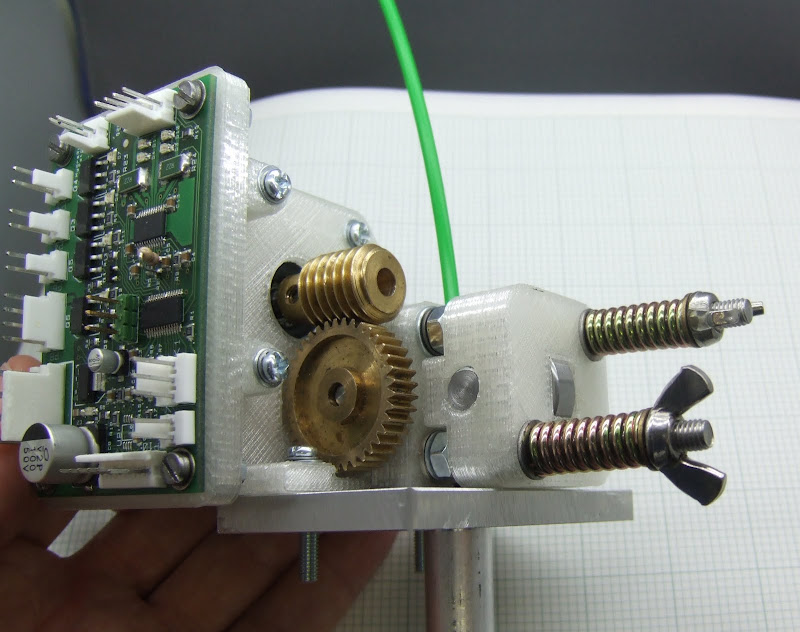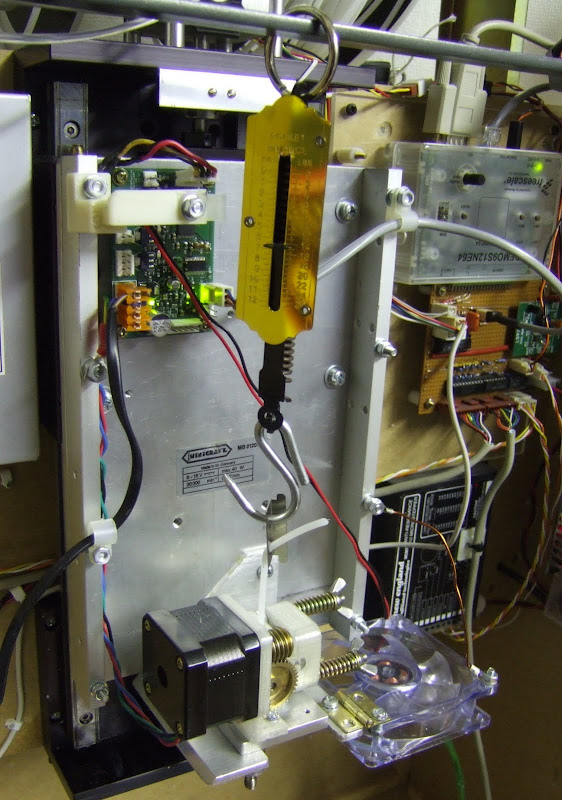The first was something I had been wanting to try for a long time, and that was reversing the extruder drive to stop ooze. My latest extruder (details to follow) has a much smaller melt chamber but still has significant ooze when extruding PLA. Erik is pursuing the Bowden extruder idea, which should benefit even more from reversing.
Because my machine is controlled by Python, rather than g-code, it is very easy to try out things like this. We hacked the code to instantaneously reverse for a short distance very quickly at the end of each filament run. After moving to the start of the next run it fast forwards the same distance that it reversed before resuming the normal flow rate.
I designed a simple test shape to allow the results to be compared. It is a 15mm square with four 5mm towers at each corner. I am not using Enrique's latest Skeinforge which I think would minimise the extruder moves in fresh air to just three per layer. This is with a very old version that does the four outlines and then returns to fill each of them in.

Plenty of hairy bits showing the ooze. These can be removed easily, but what is worse is the object will be missing that amount of plastic making it weaker. This can be extreme with a thin structure which is remote from other parts of the same object.
We tried reversing 1 mm at 8 times the extrusion speed to start with. That worked but was obviously more than was needed. We tried 0.25mm which was too little and settled on 0.5mm, although a lot of that is taken up by the motor bracket flexing. I need to make it stronger.
The result was no hair at all!

A very simple fix for a problem that has used a lot of my time in the last two years.
The second experiment was something Erik wanted to try. He has discovered that PLA is soluble in caustic soda, so potentially could be used as soluble support material for ABS. The question was: can we extrude ABS onto PLA and get it to stick well enough to resist warping?
We made a 5mm thick slab of PLA 20mm wide and 40mm long, 90% fill. On top of that we extruded a 30 x 10 x 20mm block of ABS with a 25% fill.

The ABS looks very glossy so I think it may have some PLA in it. Possibly we needed to flush it through for longer. The ABS block is also a bit scrappy. The reason was that the extruder was playing up. It was leaking plastic, hence the burnt bits and the stepper motor was skipping steps leaving a deficit of plastic. This extruder had never done ABS before and still has some teething problems, but it shows that ABS will bond to PLA well enough to stop it curling.
Next we extruded a block of PLA on top of the ABS.

That also bonded well. The messy bit at the join is because HydraRaptor did its normal circuit of the object that it normally does on the first layer but it was in mid air.
To see how well they were bonded we put the PLA base in a vice and attached a small g-clamp to the PLA block on top. The g-clamp was pulled with a strain gauge until the ABS came way from the base at about 8Kg. Interestingly the first layer outline of the ABS was left on the PLA. That was deposited at 215°C whereas the infill of the first layer was at 195°C. These are the values I use for depositing ABS onto a raft, so in an object layer on top of support it would be 240°C giving a stronger bond. See Erik's writeup and video here.
So PLA looks like a good candidate for supporting ABS. They bond well and PLA is very rigid to resist warping. It can be dissolved with drain cleaner but also I expect it would be easy to peel when softened in hot water.
All in all a good day's hacking.









